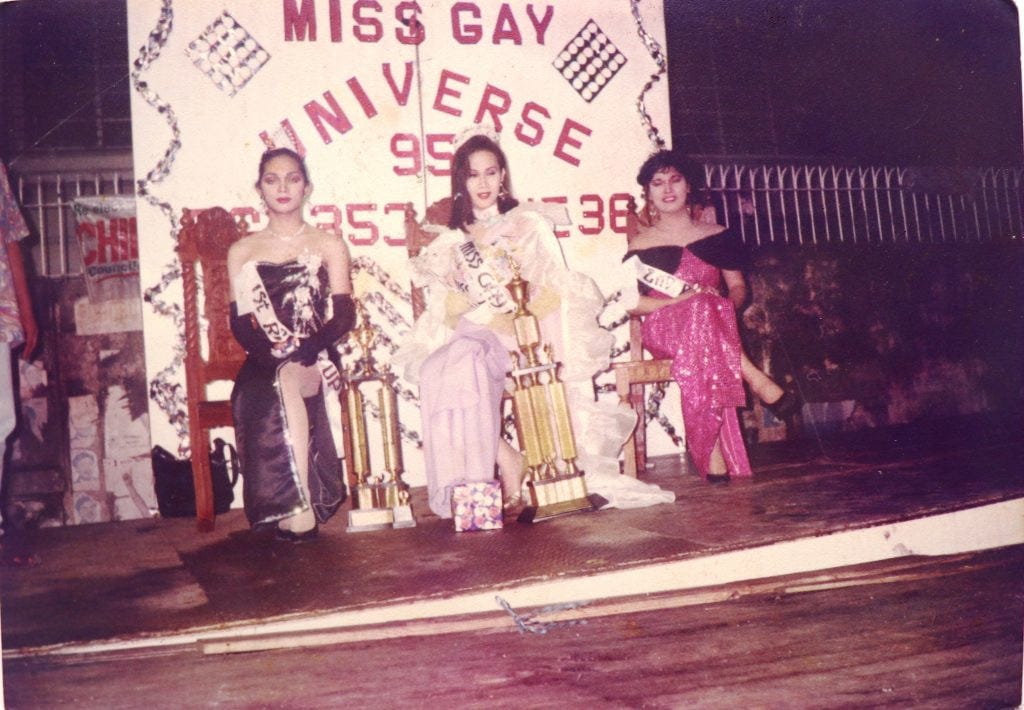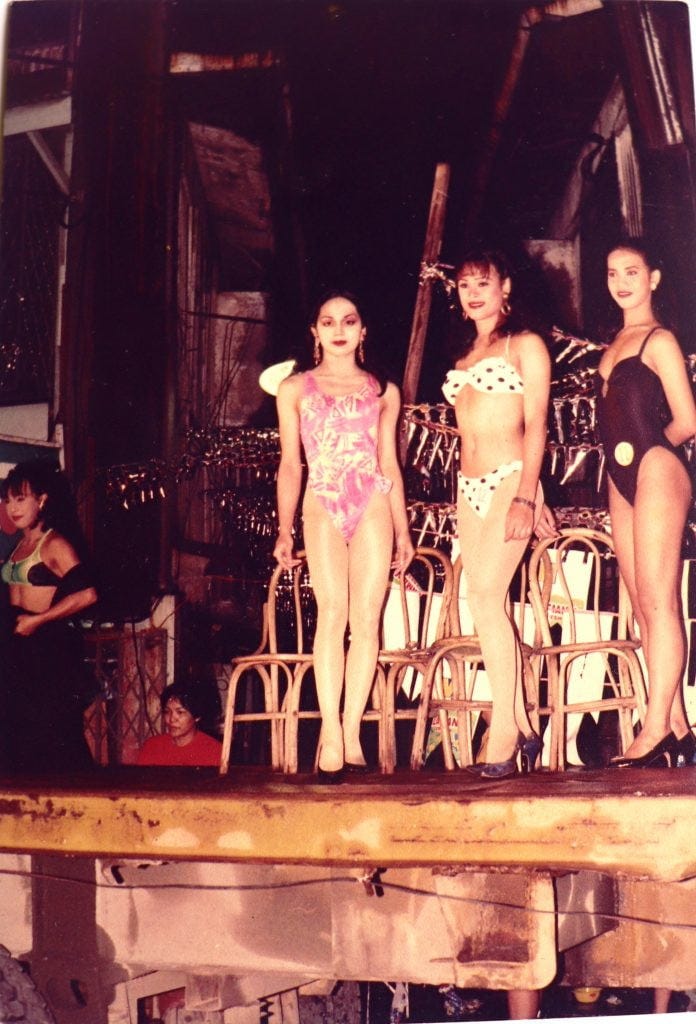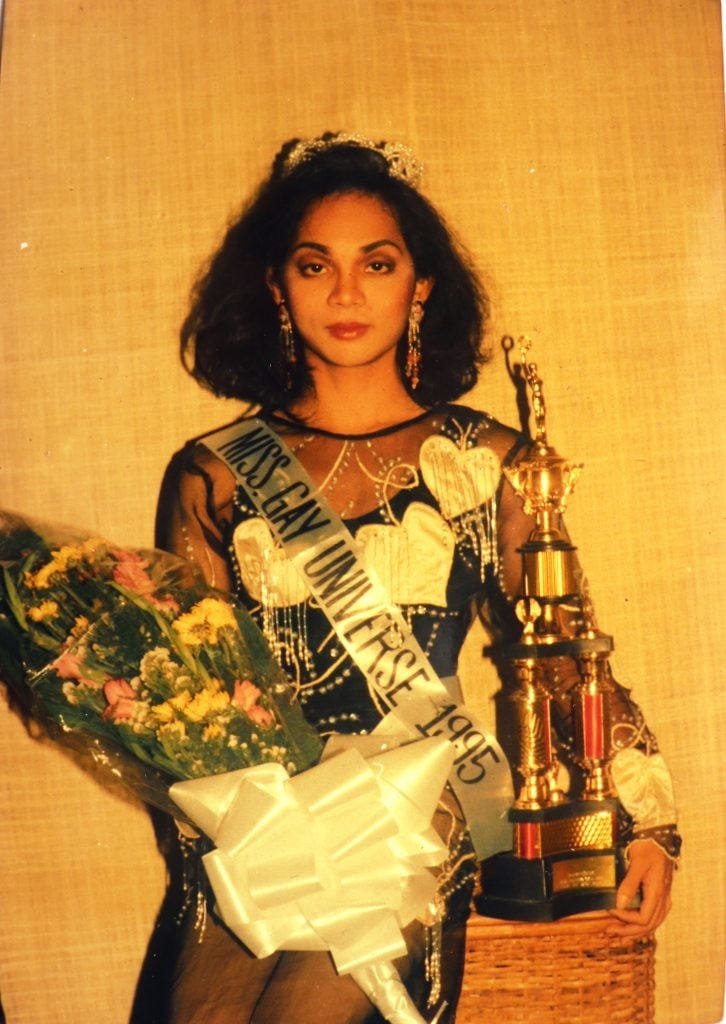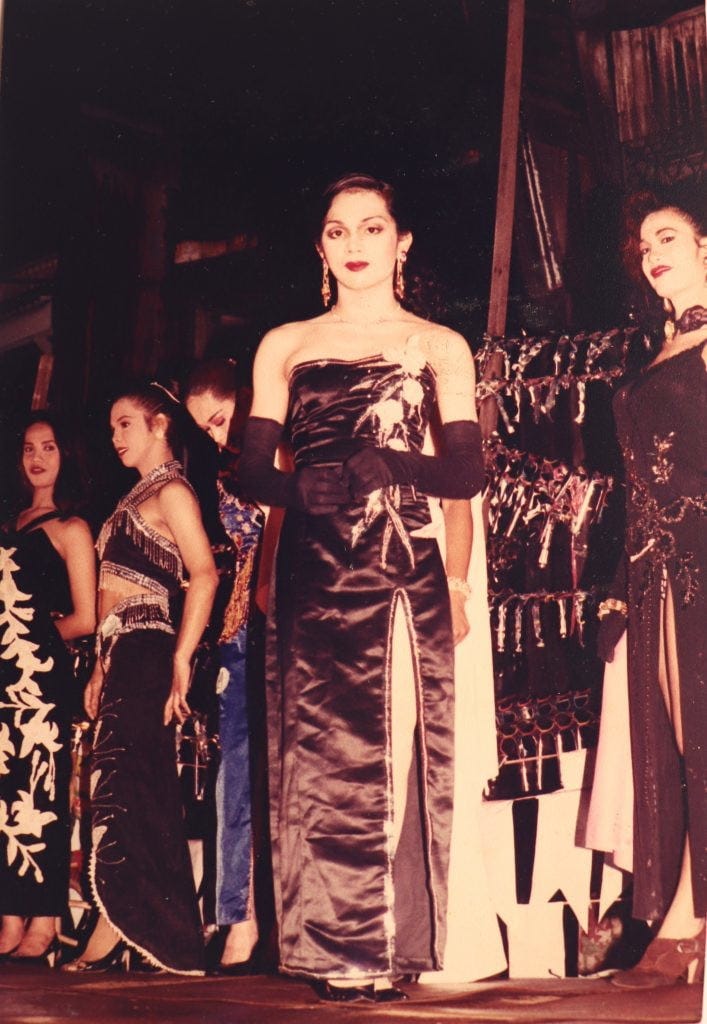Memoirs of a Pageant Beauconera
Ladyboys have been around a long time in Asia. This story is from 1995.
Many people seem to think that ladyboys are a recent phenomenon, but this is far from true. They have been a feature, in various forms, of Asian life for centuries. It's hard to find older material but I found this on a Philippines website, from a publication that is now defunct. The name of the author is not known. It gives insight into the ladyboy pageant scene in the country and across south-east Asia, and also reinforces the observation that the 'gay' and transgender scenes are closely intertwined.
A pageant can be a small local affair with a stage set up on the back of a truck, or as grandiose as the Miss Tiffany contests, held in Thailand, or Super Syrena, in the Philippines.
Memoirs of a Pageant Bakla
At 22, when most gays (discreet, screaming or confused) would have settled into their comfort zones, I indulged my inner Aphrodite and unabashedly joined a Miss Gay beauty pageant.
Growing up, I was naturally competitive, maybe because I come from a family of 11 (of eight boys and three girls), and incessantly grab attention anyway I could. I ran in the 200-meter dash and played against the varsity volleyball team (my friends and I, who were undoubtedly better and more creative at scoring, weren’t drafted into the official team of our Jesuit-run high school because, as the priests said, we were not “appropriate” representatives). I won spelling contests against older rivals and was invariably selected for verse choirs, drama fests and interschool whiz-kid competitions.
I am gay, therefore I’m mad (Boy George), or the methods to the madness
The mid-1990s was a crossroads of sorts for Miss Gay contests. The “all-natural” gays (non-operated on contenders) were slowly being supplanted (and defeated) by the surgically enhanced. (They had the unfair advantage.) It was the rise of the Japaneras and the gay prostitutes (those who can endure the torture treatments and afford the procedures to become more feminine), more womanly than real women (and I’m not saying the Pamela Anderson and Anna Nicole Smith science projects) and more modelesque than Linda, Cindy or Tweety (If they weren’t beauconeras, they could easily be drafted to the PBA).
Since they were already earning big bucks abroad, these gays weren’t in it for the money. Like me, it was for the momentary thrill, the sudden rush, the happy conceit that we were (kahit for a night lang) more beautiful than the general population.
Preparing for a pageant
Because I belonged to the “non-ops,” preparing for a pageant required more lead time — shaving, for a start, the legs, armpits and bikini area (no Brazilian wax then!); and hair and makeup for about two hours, as I would argue with my hair and makeup artist over who I should look like for the night (Claudine Barretto? Ana Roces? Beth Tamayo?)
I don’t have shapely legs, but five layers of stockings would remedy that. Uneven skin tone? Hazel Bishop liquid body foundation is a miracle whip (Hey, bronzers and aerosol tanners were unheard of!). Rolled socks would make for breasts (the right lump para believable na dalagita pa lang), then the right shading on the chest to approximate a cleavage (learned that in Cosmo![Cosmopolitan magazine]).
After all the contraptions were in place, it was time to assume a female persona. All diva attitude, but tempered just so para hindi naman magmukhang drag queen masyado. Then, voila! I am woman.
Hiram na mukha
Truth be told, a gay pageant is immensely more entertaining than a Miss Barangay this or a Mutya ng Purok that. During the Parade of Nations or the introduction phase, when a contestant screams her name as “Anjanette Abayari,” “Nanette Medved,” “Dawn Zulueta,” “Carmi Martin,” “Gloria Romero,” “Teresa Loyzaga,” “Ruffa Gutierrez,” “Carmina Villaroel” or “Phoebe Cates,” it was no empty boast or false claim.
The gays, unnervingly, were indeed the faces they coveted, some even classier and more beautiful. For my part, depending on who did my makeup, I fancied myself as Claudine Barretto or Beth Tamayo or Svetlana, a Soviet beauty. But some would snap back and say I look more like Judy Ann Santos, Daria Ramirez, Anna Capri or Lisa Bonet. Eddie Baddeo, too.
And because I tend to be didactic and scholarly in the question-and-answer portion, I quickly earned the moniker “Loren Legarda.”

No guts, no glory
Having done respectably in the brawns and brains departments, I felt the gnawing urge to find out how I would fare in the beauty arena. And before the ravages of time set in, I decided to take the plunge. But having discerned that I couldn’t possibly take on the great gay beauties of the time, I joined a pageant for first-timers at a forgotten barangay in Tondo, Manila.
Amid the squalor and foreboding sense of danger (completely unfounded), about 20 budding and blossoming beauconeras (beauty contestants) sauntered, sashayed, vamped and emoted on a makeshift stage hurriedly assembled the afternoon before the pageant.
It was a competition for neophytes, loosely meaning, first-timers, also-rans and non-veterans. As Miss Ukraine (“From the land of gymnasts, scientists and ballerinas!”), I gave it my all. All the knowledge I gained growing up watching Miss Universe, Miss World and all minor contests there ever were was put to fabulous use. I borrowed the swimsuit, cocktail dress and long gown of a friend — the legendary beauconera Joanna Roa (think Rita Hayworth and Lala Montelibano on a really good day).
Breaking into the top 10, my self-confidence quadrupled. I knew I could vanquish the competition come the question-and-answer portion. I knew I was articulate, storing at the back of my mind all the quotable quotes on virtually all issues of the day. (I kept a journal like it was my personal beauty bible).
And I knew the remaining finalists were smothered in their own stage fright and asphyxiated by the pressure they inflicted on themselves.
On a roll
Me? I was on a roll. After blowing away the judges (I think) and the audience with my straight English, breathlessness, perfect pronunciation, politico-style reply to a question on the environment, I was crowned the new Miss Gay Universe 1995 of that unremembered barangay in Tondo.
Did I mention that my friend Joanna sat as a judge in that contest? Oh well, as in all contests in this country, a little “help” doesn’t hurt in achieving your goals. (Rigging’s too heavy a word to describe my triumph, as I honestly think I was regal, smart and radiant that night. Promise!)
Anyway, I somehow proved that my beginner’s luck wasn’t a fluke. I was second runner-up on my second pageant, all the sweeter because I was up against the “veterans,” the gays who have made joining beaucons a “profession.”
In this edition, the winner was a Montecarlo, a member of the “clans,” a group of gays who’ve banded together to form cliques of only the most beautiful and well-prepared. In any contest, chances are if it’s not a Montecarlo who’s crowned, it will be a Ponti, an Artadi or a Sicangco. No one should be presumptuous to apply to be a family member, as it’s by invitation only. Needless to say, I never got such an invite.
Third Pageant
My third pageant did a lot for my self-esteem. I snared the top plum. The pageant was held in a depressing excuse of a street in Pampanga, Santa Cruz, Manila. Two or three other contests were just a few blocks away on the same night. Lucky for me, there were no veterans in my corner. For our stage, the barangay hired a 10-wheeler truck and attempted to spruce it up to befit a coronation.
More like an execution, really, as two of my friends who comprised my entourage (any self-respecting beauconera must have at least four — a makeup artist, costume-change assistant, hairdresser, wardrobe mistress) engaged in a catfight with other gay supporters. Apparently, when I did my trademark perfect English routine in the Q&A, the other gays deemed me too pretentious and too high-brow for a barangay-level “fun” event.
I was too serious, they said. In my defence, my friends (brimming with pride and haughtiness) shot back that contestants should be like me. That a “mere” beaucon should be an avenue for us to change people’s misconceptions about gays and homosexuality, yadda yadda yadda… The other gays couldn’t care less what my friends were blabbing about and a near scuffle resulted. We would have been rendered drop-dead gorgeous had not cooler heads (the tanods) prevailed.
My fourth pageant was at the Faces of the Nineties at the legendary gay bar 690 on Retiro Street, Quezon City (After this, I contemplated retiring. No kidding!). I joined the monthly elimination round, where five winners would advance to the grand event in December. The gig was in-your-face (harap-harapan), meaning you’re at eye level with the judges.
Gays who would otherwise look queenly on a stage (Spotlights and distance will render one flawless, slimmer, taller) would be reduced to mere caricatures on an intimate setting like 690. Unforgiving judges, some ageing beauconeras and fag hags who wouldn’t be fooled easily, can spot your tricks right on.
Personality
As in the real deal, gay pageant is won by the sheer force of a gay’s personality. If there are so many trappings and add-ons — big wigs, big boobs, garish gowns, stupid swimwear (what’s goin’ on down there?), mechanical delivery of replies, you’re a TYG (thank you, girl). I was myself as I could ever be, but more experienced (okay, more beautiful) gays went on to the finals.
The fifth pageant, on the very street where I lived on Severino Reyes in Santa Cruz, Manila, was an amusing episode. Many of my neighbours were incredulous that I was the one onstage competing. I forgot to mention that when I’m not on my malandi mode, my daily look is glasses and tied hair, geeky gay, or manang. Remove the glasses and put on blue contacts, and I’m a different person. I emerged first runner-up.
The next two forays were forgettable, while my eighth was not. It was in Villanueva in Cagayan de Oro City, my hometown. I competed against people I knew so it was a rather tense encounter. As we were trimmed down to the final three, Cris (Ruffa Gutierrez, though more like Imelda Papin), a towering gay, would deliberately step in front of me (a pocket Venus, naks!) so the judges would only notice him.
Undaunted, I would go down from the stage (Provincial venues were most likely at gyms) and stand in front of the judges (Cris couldn’t, because her makeup, while flawless from afar, was filthy up-close). This went on until the final judging. Needless to say, Ruffa won over Claudine.
The story, though, doesn’t end there. Just as we winners (and whiners) were happily morphing backstage into our ordinary selves, a fight suddenly ensued. A huge drunken gay (ostensibly, a fan of mine) punched one of the gay organizers (a dear friend) for supposedly cheating me of victory. Fighting like bulls (and the men that they really were), the two got into a boxing (and screaming) match.
Villanueva is known for its annual gay pageants but that was the first time that violence of that kind visited the place. Fighting for beauty; it was an unforgettable way to end my beauty pursuit.
Beauty and madness
Violence, though, hardly figured in any contest I joined. The worst that ever happened was when a disgruntled contestant, usually someone who won every major special award but wasn’t in the top five because he blew his chances in the Q&A, threatened to hurl his trophies onstage in hopes of disrupting the proceedings. Or when supporters sabotaged the remaining contestants by hiding their things, mangling the gowns or just sour-grapeing backstage to anyone who would sympathize, which would be no one, actually.
The happy finalists invariably said, “Bumawi ka na lang sa susunod na pageant, bakla!” The beauty of a beaucon is that you can always make “bawi” on the next contest, which can be sooner than the next night on the next street.







